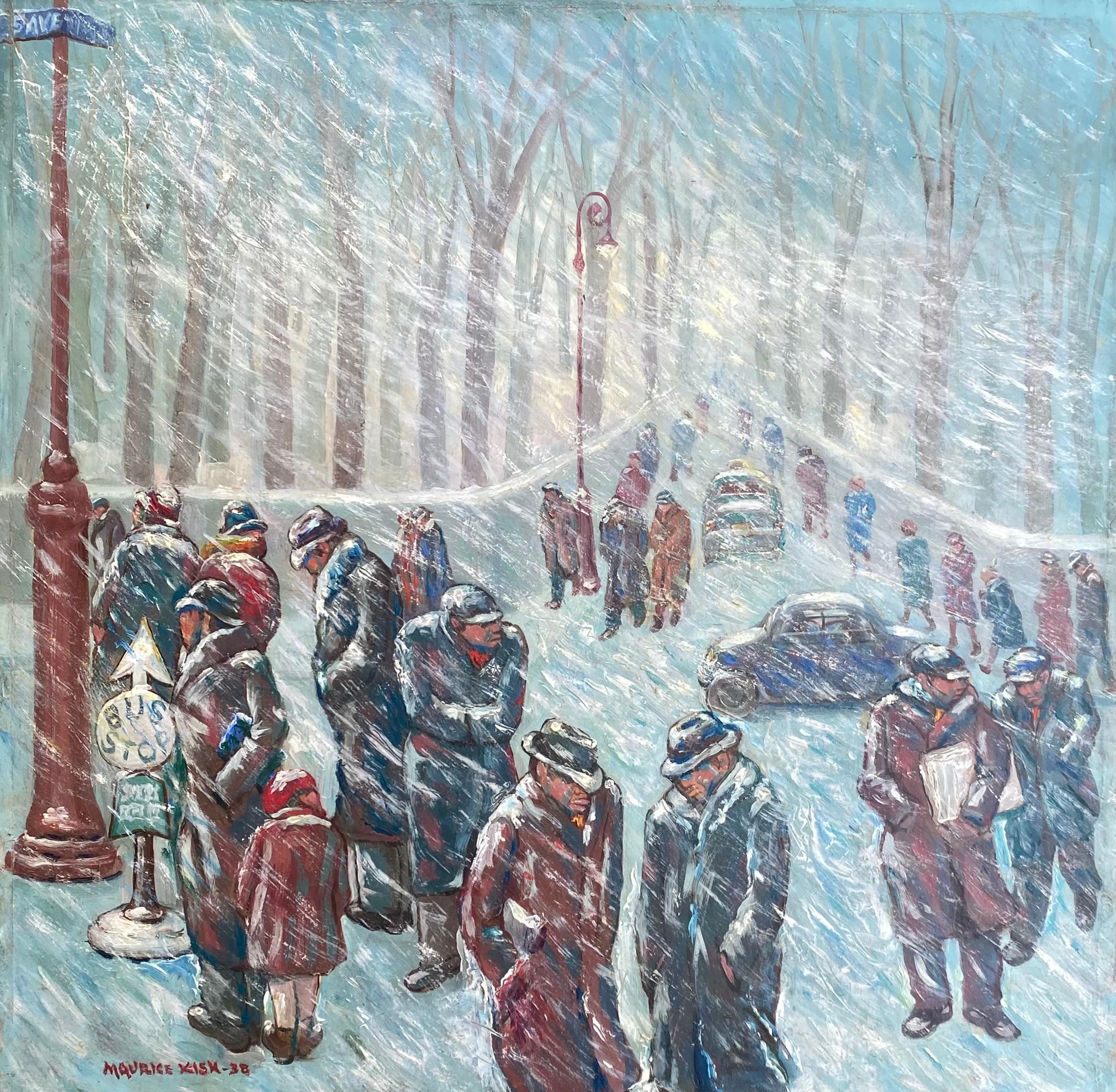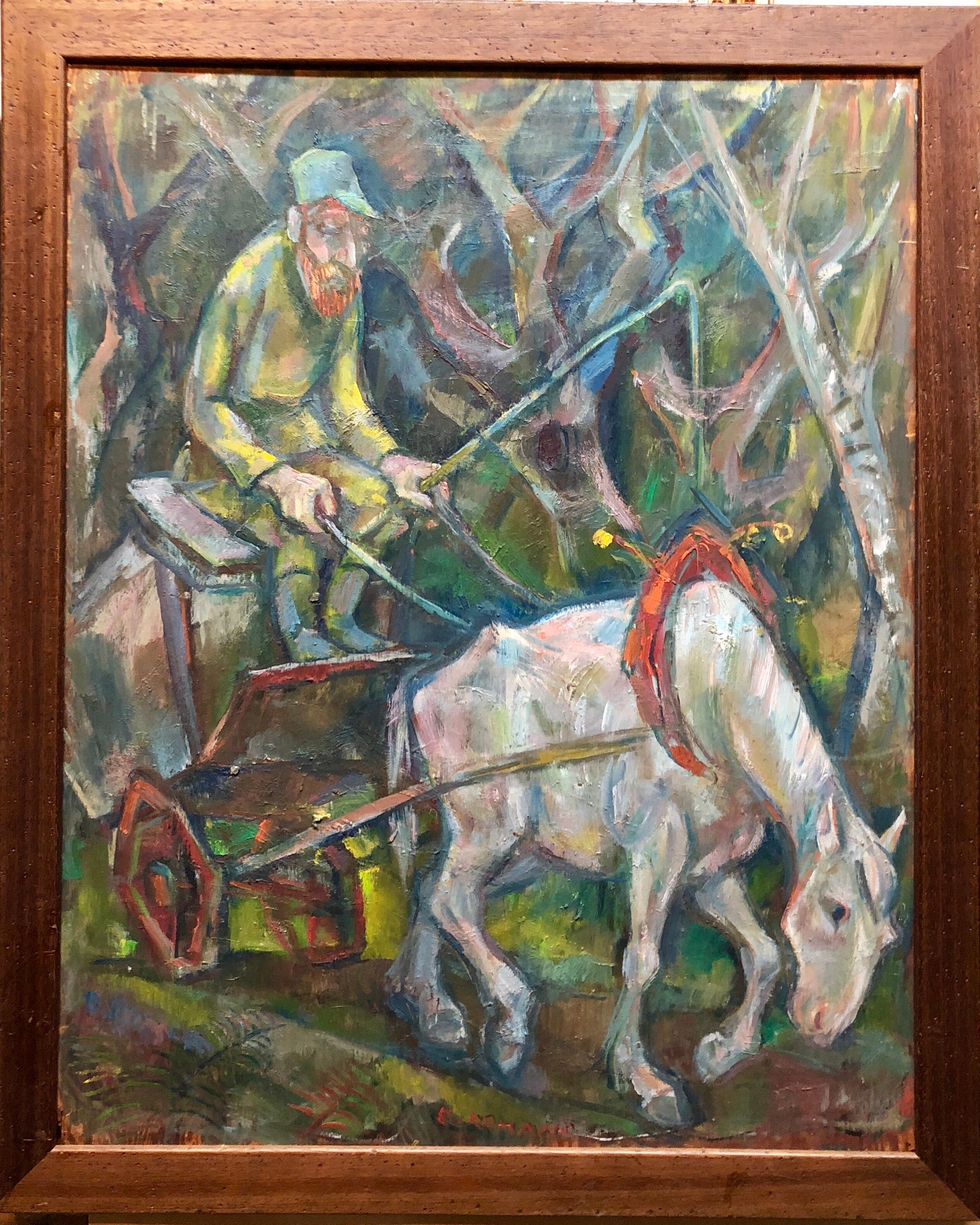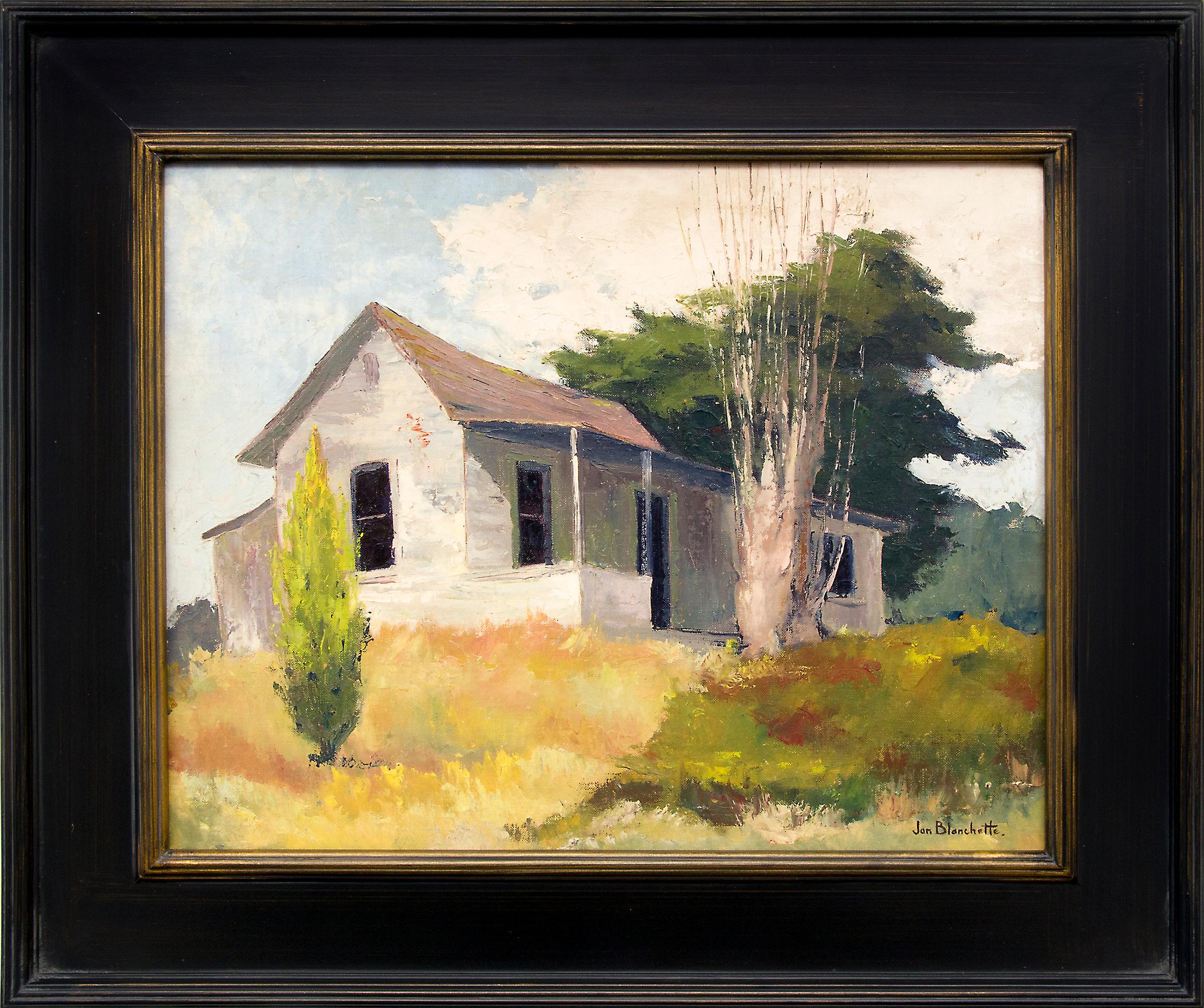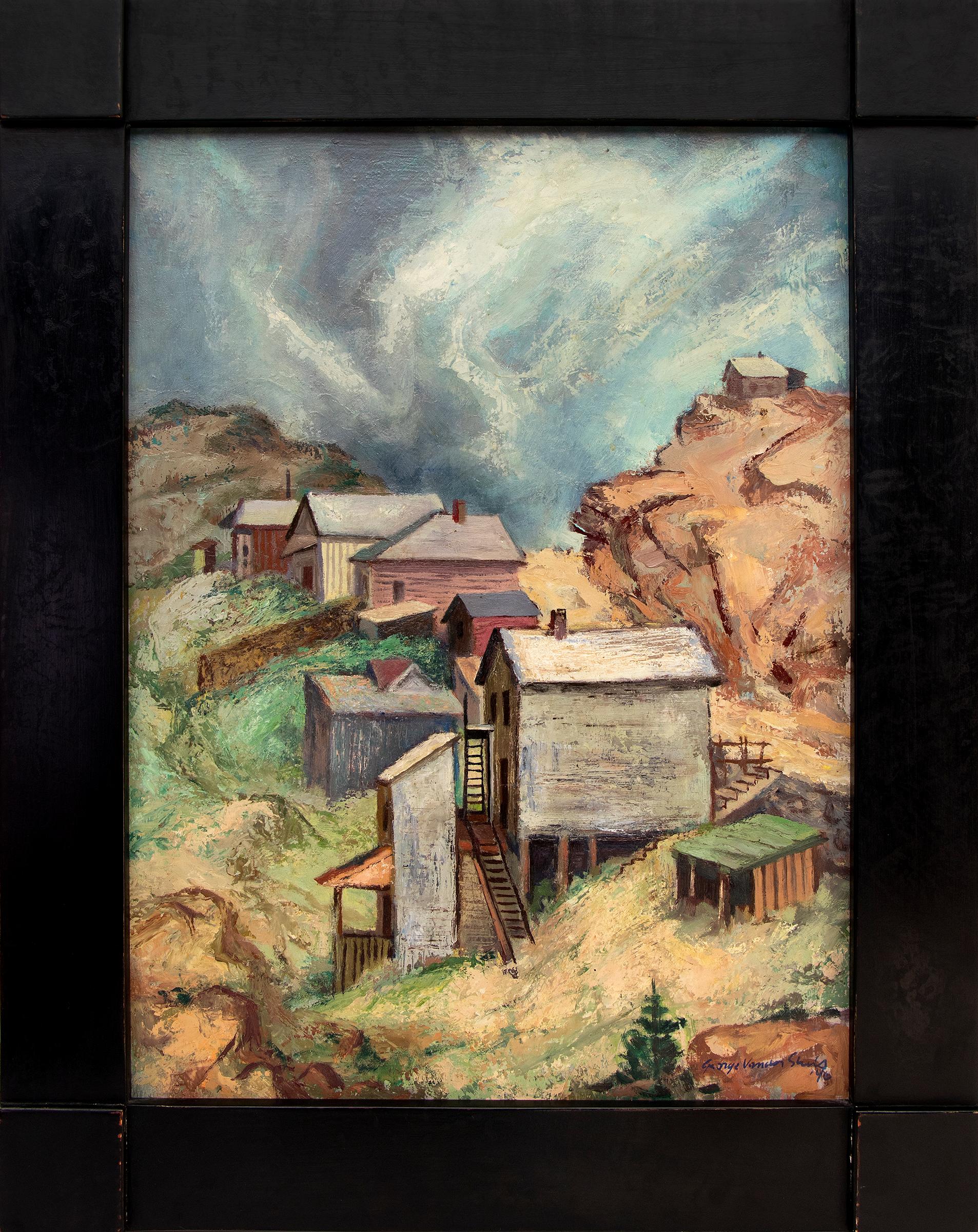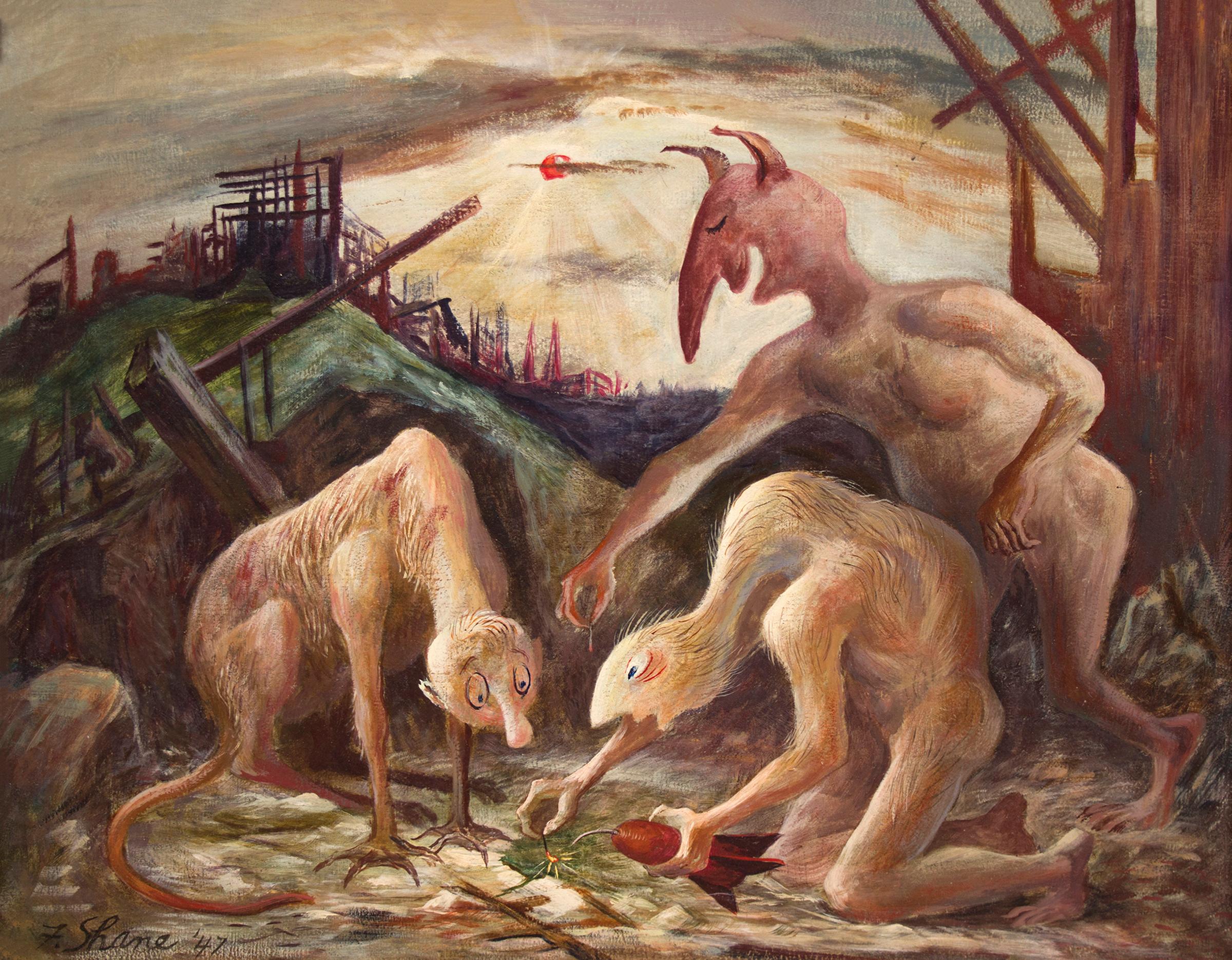Items Similar to 1972 Gestural Oil Painting Boat in Harbor Figural Abstraction Raoul Middleman
Want more images or videos?
Request additional images or videos from the seller
1 of 16
Raoul Middleman1972 Gestural Oil Painting Boat in Harbor Figural Abstraction Raoul Middleman1972
1972
About the Item
Raoul Middleman (born 1935 in Baltimore, Maryland) is an American painter. Middleman has been a member of the Maryland Institute College of Art faculty since 1961. American University Museum at the Katzen Center has described Middleman as a "Baltimore maestro [whose] nudes are not pretty—they are sagging, dimpled, and real. His cityscapes reveal the underbelly of post-industrial rot, his narrative paintings give contemporary life to his personal obsessions. They are intelligent, messy, and utterly masterful."
From an interview with RM "I was doing abstract art. Then Roy Lichtenstein came around, and I wanted to be current. I remember Grace Hartigan said, “You’ve gotta go to New York, seize destiny by the hand.” My friend Jon Schueler took my slides up to Eleanor Ward, who had the Stable Gallery. My Pop art paintings were discovered. I moved to New York into Malcolm Morley’s old loft down on South Street. Agnes Martin was upstairs... People who interest me come from different quarters. I knew guys around Schueler, like B.H. Friedman. But I also knew the Pop world pretty well – Al Hansen, Richard Artschwager, Lichtenstein. I became friends with Raoul Hague and I rented a place in Port Jervis, New York. I started doing my first landscapes up there. I thought making landscapes was the dumbest thing you could do. You got flies, insects, cow pies, humidity. But I loved it... I went down to the meetings of the Figurative Alliance. I met my friends there — Paul Resika, Paul Georges, Rosemarie Beck, Louis Finkelstein, Gretna Campbell. Gabriel Laderman — he was difficult and complex, but ultimately supportive. Marjorie Kramer and Sam Thurston. They were welcoming."
Paintings by Raoul Middleman can be found in private and corporate collections such as Baltimore Museum of Art, MD; Johns Hopkins Hospital, Baltimore, MD; Corcoran Gallery of Art, Washington DC; National Gallery of Art, Washington DC; Metropolitan Museum of Art, NY; National Academy of Design, NY; New York Public Library, NY; and Syracuse University, NY.
The C. Grimaldis Gallery in Baltimore, Maryland has represented Raoul Middleman since 1977. Troika Gallery Troika Gallery in Easton, Maryland has represented Raoul Middleman since 1997.
Education: 1959, Pennsylvania Academy of Fine Arts, Philadelphia, Pennsylvania
1961 Brooklyn Museum Art School, Brooklyn, New York
1960 Skowhegan Summer School, Skowhegan, Maine
1955 B.A. Johns Hopkins University, Baltimore, Maryland
Selected Solo Exhibitions
Kouros Gallery, New York, NY
C. Grimaldis Gallery, Baltimore, MD
The Painting Center, New York, NY
Rodger Lapelle Galleries, Philadelphia, PA
Bavarian Paintings, Murnau, Germany
MB Modern, New York, NY
Troika Gallery, Easton, MD
Ice Gallery, New York, NY
Ingber Gallery, New York, NY
Contemporary Realist Gallery, San Francisco, CA
Swanston Fine Arts, Atlanta, GA
Allan Stone Gallery, New York, NY
Kornbluth Gallery (with Wolf Kahn), Fair Lawn, NJ
William Capro Gallery, New Bedford, MA
Boston University, Boston, MA
Yale Summer School of Art, Norfolk, CT
Scott-McKennis Gallery, Richmond, VA
Krasner Gallery, New York, NY
Selected Group Exhibitions
C. Grimaldis Gallery, Baltimore, MD, “Narrative Visions, Works by: Grace Hartigan, Beverly McIver,
Raoul Middleman, George McNeil, Sangram Majumdar, David Rich, and Tony Shore”
National Academy, New York, NY Annual Exhibition
Ice Gallery, New York, NY
C. Grimaldis Gallery, Baltimore, MD “The Painterly Landscape”
American Academy of Arts and Letters, New York, NY “Invitational Exhibition”
Gaumann Cicchino Gallery, Fort Lauderdale, FL “The Landscape Revisited from Maine to Key West”
Haus der Kunst, Munich “Das Automobil in der Kunst”
George Washington University, Washington, DC “The Painterly Vision”
Selected Collections
Baltimore Museum of Art, Baltimore, MD
Corcoran Gallery of Art, Washington, DC
Johns Hopkins Hospital, Baltimore, MD
Metropolitan Museum of Art, New York, NY
National Academy of Design, New York, NY
National Gallery of Art, Washington, DC
New York Public Library, New York, NY
Syracuse University, Syracuse, NY
Towson University, Towson, MD
University of Maryland, College Park, MD
Selected Awards & Honors
Edwin Palmer Memorial Prize, National Academy of Design, New York, NY
Artist In Residence, LMCC, World Trade Center, New York, NY
President, National Academy of Design, New York, NY
Benjamin Altman Prize for Figure Painting, National Academy of Design, New York, NY
Robert & Rochelle Phillip Prize, National Academy of Design, New York, NY
- Creator:Raoul Middleman (1935, American)
- Creation Year:1972
- Dimensions:Height: 19 in (48.26 cm)Width: 24 in (60.96 cm)
- Medium:
- Movement & Style:
- Period:
- Condition:good, minor wear commensurate with age.
- Gallery Location:Surfside, FL
- Reference Number:1stDibs: LU3825725172
About the Seller
4.9
Platinum Seller
These expertly vetted sellers are 1stDibs' most experienced sellers and are rated highest by our customers.
Established in 1995
1stDibs seller since 2014
1,539 sales on 1stDibs
Typical response time: 1 hour
- ShippingRetrieving quote...Ships From: Surfside, FL
- Return PolicyA return for this item may be initiated within 3 days of delivery.
More From This SellerView All
- Bathers at the Quarry 1940s American Modernist Oil Painting WPA eraBy Theresa Berney LoewLocated in Surfside, FLSwimmers and sun tanners at the local watering hole. Her birth name was Theresa Berney. At the time of her passing she was known as Theresa Loew. Birth place: Baltimore artist, blo...Category
1940s American Modern Landscape Paintings
MaterialsOil, Board
- Large Modernist Oil Painting 1940s, Judaica Hasidic Shtetl Wagon Driver WPA EraBy Emanuel Glicenstein RomanoLocated in Surfside, FLGenre: Modern Subject: Landscape with figure of horse, driver and wagon Medium: Oil Surface: wood Board EMANUEL ROMANO Rome, Italy, b. 1897, d. 1984 Emanuel Glicen Romano was born in Rome, September 23, 1897. His father Henryk Glicenstein was a sculptor and was living in Rome with his wife Helena (born Hirszenberg) when Emanuel was born. His father obtained Italian citizenship and adopted the name Enrico. Emanuel was brought up in Italy, Switzerland, Germany, England and Poland. In 1926 Emanuel Glicenstein Romano and his father sailed for New York. They briefly visited Chicago. Romano's sister, Beatrice, and mother only joined them in New York years later. Romano changed his name on his arrival to America and some have erroneously speculated that this was to avoid antisemitic discrimination. In truth, as the son of a highly-regarded artist, Romano changed his name to ensure that any success or recognition he would later attain, would be the result of nothing other than his own merit as an artist, and not on account of his father's fame. In 1936 Romano was worked for the WPA Federal Art Project creating murals. ( there were many jewish artists active with in the WPA period. notably Chaim Gross, Ben Shahn, Isaac and Moses Soyer, Abraham Rattner and many others. During and immediately after World War II, Romano created a series of allegorical works depicting graphic holocaust images that were held closely by the family until after his passing. One of these works is now on permanent display in the Florida Holocaust Museum in St. Petersburg Florida. Emanuel's father died in 1942 in a car accident before they could realize their shared dream of visiting Israel. In 1944 Romano, having completed his degree at the Pennsylvania Academy of Fine Arts and the Art Institute of Chicago, began teaching at the City College of New York. Romano moved to Safed, Israel in 1953 and established an art museum in his father's memory, the Glicenstein Museum. COLLECTIONS Indianapolis Museum of Art Metropolitan Museum of Art Boston Fine Arts Museum Fogg Museum Musée Nacional de France Recently his work has been added to the Florida Holocaust Museum collection. His notable works include his holocaust themed allegorical paintings as well as portraits of Marianne Moore, his father and William Carlos Williams...Category
1930s American Modern Figurative Paintings
MaterialsOil, Board
- Simka Simkhovitch WPA Artist Oil Painting American Modernist Landscape Pond TreeBy Simka SimkhovitchLocated in Surfside, FLSimka Simkhovitch (Russian/American 1893 - 1949) This came with a small grouping from the artist's family, some were hand signed some were not. Thes...Category
1930s American Modern Landscape Paintings
MaterialsOil, Board
- Simka Simkhovitch WPA Artist Oil Painting Gouache American Modernist PowerlineBy Simka SimkhovitchLocated in Surfside, FLSimka Simkhovitch (Russian/American 1893 - 1949) This came with a small grouping from the artist's family, some were hand signed some were not. These were studies for larger paintings. Simka Simkhovitch (Симха Файбусович Симхович) (aka Simka Faibusovich Simkhovich) (Novozybkov, Russia May 21, 1885 O.S./June 2, 1885 N.S.—Greenwich, Connecticut February 25, 1949) was a Ukrainian-Russian Jewish artist and immigrant to the United States. He painted theater scenery in his early career and then had several showings in galleries in New York City. Winning Works Progress Administration (WPA) commissions in the 1930s, he completed murals for the post offices in Jackson, Mississippi and Beaufort, North Carolina. His works are in the permanent collections of the Dallas Museum of Art, the National Museum of American Art and the Whitney Museum of American Art. Born outside Kyiv (Petrograd Ukraine) into a Jewish family who owned a small department store. During a severe case of measles when he was seven, Simcha Simchovitch sketched the views outside his window and decided to become an artist, over his father's objections. Beginning in 1905, he studied at the Grekov Odessa Art School and upon completion of his studies in 1911 received a recommendation to be admitted to the Imperial Academy of Arts. Though he enrolled to begin classes in architecture, painting, and sculpture at the Imperial Academy, he was dropped from the school roster in December because of the quota on the number of Jewish students and drafted into the army. Simchovitch served as a private in the 175th Infantry Regiment Baturyn [ru] until his demobilization in 1912. Re-enrolling in the Imperial Academy, he audited classes. Simka Simkhovitch exhibited paintings and sculptures in 1918 as part of an exhibition of Jewish artists and in 1919 placed 1st in the competition "The Great Russian Revolution" with a painting called "Russian Revolution" which was hung in the State Museum of Revolution. In 1922, Simkha Simkhovitch exhibited at the International Book Fair in Florence (Italian: Fiera Internazionale del Libro di Firenze). In 1924, Simkhovitch came to the United States to make illustrations for Soviet textbooks and decided to immigrate instead. Initially he supported himself by doing commercial art and a few portrait commissions. In 1927, he was hired to paint a screen for a scene in the play "The Command to Love" by Fritz Gottwald and Rudolph Lothar which was playing at the Longacre Theatre on Broadway. Art dealers began clamoring for the screen and Simkhovitch began a career as a screen painter for the theater. Catching the attention of the screenwriter, Ernest Pascal, he worked as an illustrator for Pascal, who then introduced him to gallery owner, Marie Sterner. Simkhovitch's works appeared at the Marie Sterner Gallery beginning with a 1927 exhibit and were repeated the following year. Simkhovitch had an exhibit in 1929 at Sterner's on circus paintings. In 1931, he held a showing of works at the Helen Hackett Gallery, in New York City and later that same year he was one of the featured artists of a special exhibit in San Francisco at the California Palace of the Legion of Honor in Lincoln Park. The exhibit was coordinated by Marie Sterner and included four watercolors, including one titled "Nudes". He is of the generation of Russian Soviet artists such as Isaac Pailes, Serge Charchoune, Marc Chagall, Chana Orloff, Isaac Ilyich Levitan, and Ossip Zadkine. In 1936, Simkhovitch was selected to complete the mural for the WPA Post office project in Jackson, Mississippi. The mural was hung in the post office and courthouse in 1938 depicted a plantation theme. Painted on the wall behind the judge’s bench, “Pursuits of Life in Mississippi”, a depiction of black workers engaged in manual labor amid scenes of white professionals and socialites, was eventually covered over in later years during renovations due to its stereotypical African American imagery. Simka painted what he thought was typical of Jackson. His impression of pre-civil rights Mississippi was evidently Greek Revival column houses, weeping willow trees, working class families, and the oppression of African Americans. He painted African American men picking cotton, while a white man took account of the harvest and a white judge advised a white family, calling it Pursuits of Life in Mississippi. Though clearly endorsed by the government and initially generally well-received, the mural soon raised concerns with locals as the climate toward racial segregation began to change. The main concern was whether depictions that show African Americans in subjugated societal roles should be featured in a courtroom. The following year, his painting "Holiday" won praise at an exhibition in Lincoln, Nebraska. In 1940, Simkhovitch's second WPA post office project was completed when four murals, "The Cape Lookout Lighthouse and the Orville W. Mail Boat", "The Wreck of the Crissie Wright", "Sand Ponies" and "Canada Geese" were installed in Beaufort, North Carolina. The works were commissioned in 1938 and did not generate the controversy that the Jackson mural had. The main mural is "The Wreck of the Crissie Wright" and depicts a shipwreck which had occurred in Beaufort in 1866. "The Cape Lookout Lighthouse and the Orville W. Mail Boat" depicted the lighthouse built in 1859 and the mail boat that was running mail during the time which Simkhovitch was there. The boat ran mail for the area until 1957. "Sand Ponies" shows the wild horses common to the North Carolina barrier islands and "Canada Geese" showed the importance of hunting and fishing in the area. All four murals were restored in the 1990s by Elisabeth Speight, daughter of two other WPA muralists, Francis Speight...Category
1930s American Modern Landscape Paintings
MaterialsGouache, Oil, Board
- New Yorker Magazine Cover Oil Painting New England Porch View Folk Art AmericanaBy Gretchen Dow SimpsonLocated in Surfside, FLThis is a hand painted copy of the New Yorker Magazine cover image from September 25, 1978. It is not signed. I was told it is not by the artist. I am selling it as in the style of Gretchen Dow Simpson...Category
1970s American Modern Figurative Paintings
MaterialsOil, Illustration Board
- Simka Simkhovitch WPA Artist Oil Painting American Modernist Landscape w TowerBy Simka SimkhovitchLocated in Surfside, FLSimka Simkhovitch (Russian/American 1893 - 1949) This came with a small grouping from the artist's family, some were hand signed some were not. Thes...Category
1930s American Modern Landscape Paintings
MaterialsOil, Board
You May Also Like
- Waiting for the Bus in a Blizzard- WPA American Scene 1938 NYC Modernism RealismBy Maurice KishLocated in New York, NYWaiting for the Bus in a Blizzard- WPA American Scene 1938 NYC Modernism Realism. 16 x 16 inches, Oil on board, Signed and dated 1938 lower left. ...Category
1930s American Modern Figurative Paintings
MaterialsOil, Board
- Near Watsonville, California, Mid Century Landscape Oil Painting House TreesBy Jon BlanchetteLocated in Denver, COMid 20th Century oil on artist board of a white house near Watsonville, California. 1950s landscape painting with house and trees. Presented in a...Category
Mid-20th Century American Modern Landscape Paintings
MaterialsOil, Board
- Storm Over Victor (Colorado Mountain Town), 1940s WPA Era Landscape Oil PaintingLocated in Denver, COOil on board painting by George Vander Sluis (1915-1984) titled Storm Over Victor (Colorado Mountain Town) from 1946. WPA Era Mountain Landscape wi...Category
1940s American Modern Landscape Paintings
MaterialsOil, Board
- Twilight of History, Figurative American Modernist Oil Painting, Gold Green RedBy Frederick ShaneLocated in Denver, CO"Twilight of History" is an original oil on board painting by Frederick Shane (1906-1992) from 1947. Shane's reflection of the twilight of our existence is shown with three creatures...Category
1940s American Modern Figurative Paintings
MaterialsOil, Board
- "Mutual Admiration" Flower Mid-Century Modern Oil Painting Monterey ArtistLocated in Soquel, CA"Mutual Admiration" Flower Mid-Century Modern Oil Painting Monterey Artist Mid-Century Modern painting of a little blonde girl in a white apron adoring her flowers by Monterey Artist Rose Marie (Smith) Ansel, (American, 1921-2012) Rose Marie was born and lived in the Monterey area all her life. She volunteered in various city government associations and founded the Parade of Nations in 1970 which celebrated the many ethnic cultures on the Monterey Peninsula...Category
1960s American Modern Figurative Paintings
MaterialsCanvas, Oil, Illustration Board
- WPA Scene American Modernism 20th Century Workers Strike Realism IndustrialLocated in New York, NYWPA Scene American Modernism 20th Century Workers Strike Realism Industrial "Pawns" 16 x 20 inches,. Oil on board, c. 1930’s. Signed lower left. Stowell Sherman...Category
1930s American Modern Figurative Paintings
MaterialsOil, Board
Recently Viewed
View AllMore Ways To Browse
Key Board
Boats In A Harbor
Harbor Boat Painting
Munich 1972
Ny Mets
Boats In Harbor Painting
Board Of Trade
Harbor Boats Art
Boats In A Harbor Painting
Modern Art Oil Boats
New Bedford
Cows And Landscape Paintings
Pretty Landscape Painting
Landscape Oil Painting With Cows
Vintage Md
Vintage Go Board
San Francisco Cityscape Paintings
American Paintings Cows

